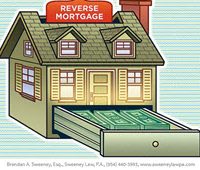Reverse Mortgages: Are They Really One of the Coolest Things Since Sliced Bread?

Recently one of my favorite actors from the 1980s, Tom Selleck, has seen an increase in his screen time. The former Magnum PI star is not playing another dramatic role whipping around Hawaii in a bright red Ferrari, but instead is informing the public and serving as a spokesperson about the benefits of reverse mortgages in advertisements throughout the country.
There is a reason for the increase in advertisements regarding reverse mortgages, the “baby boom” generation, those born from 1946 to 1964, are increasingly retiring and the homeownership rate for individuals aged 55-64 is about 74%. It has been estimated that homeowners aged 62 and older have a combined $3.84 trillion of equity in their homes. Furthermore, rising health care costs coupled with longer life spans means that many baby-boomers will outlive their retirement fund, assuming that they even have one. As such, the reverse mortgage lenders would like to tap into this huge amount of equity that “baby boomers” have established in their homes.
What is a reverse mortgage?
A reverse mortgage is a special type of home loan that lets the borrower convert a portion of the equity in their home into cash. A nice way to think of it is having your home act as an ATM that can give you money from the equity in your home whenever you want.
Types of Reverse Mortgages
There are currently three types of reverse mortgages. First, the single purpose reverse mortgage, offered by some state, local, and nonprofit organizations. These types of reverse mortgages can be used for only one purpose, which is specified by the government or nonprofit lender, for example the loan can only be utilized for home repairs. Second, proprietary reverse mortgages, are private loans backed by the companies that develop them. Third, and the most common, federally insured reverse mortgages are Home Equites Conversion Mortgage (HECM).
In order to qualify for a HECM, the Federal House Administration (FHA) requires that: the borrower be 62 years of age or older; own the home without any mortgage debt, or have a very low mortgage debt that can be paid off with the proceeds from the reverse mortgage; be able to pay the taxes and insurance on the property; and the borrower must live in the home. There are also requirements with respect to the type of homes that are eligible for HECMs. The home must be a single-family home or a 2-4 unit home with one unit occupied by the borrower. Additionally, HUD-approved condominiums and manufactured homes that meet FHA requirements are also eligible for HECMs. Lastly, the FHA requires that the potential borrower receive loan counseling from an independent third party informing them of the details of the loan and any other viable options depending upon the borrower’s financial circumstances.
Characteristics of Reverse Mortgages
Reverse mortgages are “rising debt” loans, that is the balance increases over time. The accruing interest and principal amount of the payments to the borrower are a lien held by the reverse mortgage lender on the home. If done correctly, the reverse mortgage lender will have a first lien on the home. However, issues do arise with respect to the reverse mortgage lenders lien priority in the home. The balance of the debt must be paid once the borrower no longer lives in the property. Reverse mortgages are “non-recourse” loans, meaning the borrower cannot owe the lender any more than the value of their home. Moreover, there are many different types of payment plans available for both fixed rate and adjustable rate loans. As for adjustable rate reverse mortgage loans, the following types of payments plans are commonly utilized by borrowers:
- Single Disbursement Lump Sum: a single lump sum disbursement at mortgage closing. I always jokingly refer to this as the Vegas option, take the money and see what happens.
- Line of Credit: unscheduled payments or in installments, at times and in an amount of your choosing until the line of credit is exhausted.
- Tenure: equal monthly payments as long as at least one borrower lives and continues to occupy the property as a principal residence.
- Modified Tenure: combination of line of credit and scheduled monthly payments for as long as you remain in the home.
- Term: equal monthly payments for a fixed period of months selected.
- Modified Term: combination of line of credit plus monthly payments for a fixed period of months selected by the borrower.
What Happens When the Borrower Dies
Upon the death of the borrower, if the borrower’s heirs want to keep the home then they have the option of repaying the loan by paying the lower of the loan balance in full or 95 percent of the home’s appraised value. Or, what most often occurs is that the heirs simply allow to home to go over to the reverse mortgage lender, and the heirs go about their merry way while their loved one was able to use the equity in their home for home renovations, living expenses, medical expenses, or an amazing bucket list trip.
Sweeney Law, P.A. Regularly Represents Parties Dealing with Reverse Mortgage Issues
Brendan A. Sweeney, Esq., of Sweeney Law, P.A., has litigated complex reverse mortgage issues throughout Florida. Brendan A. Sweeney, Esq., is an AV Preeminent Martindale Rated Attorney, that has been recognized as a Florida Legal Elite Rising Star Attorney in 2014, 2015, 2016 2017, and 2018. If you have any reverse mortgage issues then contact Sweeney Law, P.A. at (954) 440-3993 immediately to protect your rights. www.sweeneylawpa.com.

